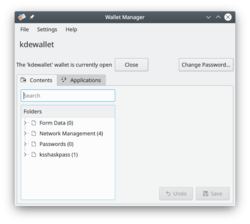KDE Wallet Manager: Difference between revisions
Appearance
No edit summary |
Marked this version for translation |
||
| Line 2: | Line 2: | ||
<translate> | <translate> | ||
<!--T:1--> | |||
{|class="tablecenter vertical-centered" | {|class="tablecenter vertical-centered" | ||
|[[Image:Kwalletmgr.png|250px]]|| ||'''KWalletManager manages all your passwords in an encrypted file''' | |[[Image:Kwalletmgr.png|250px]]|| ||'''KWalletManager manages all your passwords in an encrypted file''' | ||
|} | |} | ||
<!--T:2--> | |||
'''KWalletManager''' is an optional tool which can greatly assist your work-flow while maintaining security. | '''KWalletManager''' is an optional tool which can greatly assist your work-flow while maintaining security. | ||
* ''Wallets'' are encrypted against your chosen passphrase | * ''Wallets'' are encrypted against your chosen passphrase | ||
| Line 12: | Line 14: | ||
* You control which applications may use the wallet - everything else will have to ask you for a password. | * You control which applications may use the wallet - everything else will have to ask you for a password. | ||
<!--T:3--> | |||
A right-click, context menu on the wallet in '''kwalletmanager''' offers maintenance options: | A right-click, context menu on the wallet in '''kwalletmanager''' offers maintenance options: | ||
* To create a new wallet | * To create a new wallet | ||
| Line 19: | Line 22: | ||
* To close or delete the wallet | * To close or delete the wallet | ||
<!--T:4--> | |||
Clicking (or in some versions, double-clicking) on a wallet allows you to examine the contents of a wallet. From here you can remove any entries that you do not wish to be further controlled by the wallet. A further advantage is that it is possible to examine the passwords for individual entries - particularly useful if you have mis-typed a password and stored it. These activities remain secure, since they are only available after you have given the passphrase. | Clicking (or in some versions, double-clicking) on a wallet allows you to examine the contents of a wallet. From here you can remove any entries that you do not wish to be further controlled by the wallet. A further advantage is that it is possible to examine the passwords for individual entries - particularly useful if you have mis-typed a password and stored it. These activities remain secure, since they are only available after you have given the passphrase. | ||
| Line 24: | Line 28: | ||
<!--T:5--> | |||
{{Tip|1=''For greater security'' configure '''KWalletManager''' to use one wallet for local passwords and a separate one for network passwords and form data.}} | {{Tip|1=''For greater security'' configure '''KWalletManager''' to use one wallet for local passwords and a separate one for network passwords and form data.}} | ||
<!--T:6--> | |||
[[Category:Utilities]] | [[Category:Utilities]] | ||
[[Category:Security]] | [[Category:Security]] | ||
</translate> | </translate> | ||
Revision as of 17:32, 18 September 2010
 |
KWalletManager manages all your passwords in an encrypted file |
KWalletManager is an optional tool which can greatly assist your work-flow while maintaining security.
- Wallets are encrypted against your chosen passphrase
- Wallets are, by default, closed. Your passphrase is required to open a wallet
- Wallets can be configured to close when unused
- You control which applications may use the wallet - everything else will have to ask you for a password.
A right-click, context menu on the wallet in kwalletmanager offers maintenance options:
- To create a new wallet
- To open and examine the selected wallet
- To change the passphrase for that wallet
- To disconnect an application currently using that wallet
- To close or delete the wallet
Clicking (or in some versions, double-clicking) on a wallet allows you to examine the contents of a wallet. From here you can remove any entries that you do not wish to be further controlled by the wallet. A further advantage is that it is possible to examine the passwords for individual entries - particularly useful if you have mis-typed a password and stored it. These activities remain secure, since they are only available after you have given the passphrase.

